Class 9 FRANK Solutions Biology Chapter 7: Flowers
Scoring high marks in your exam is achievable by strengthening your conceptual understanding with Frank Solutions for ICSE Class 9 Biology Chapter 7 Flowers. In this chapter, you can study the different parts of a typical flower. Learn about Corolla, Filament, Anther, petal and more with accurately-labelled diagrams of flowers.
Study ICSE Class 9 Biology syllabus concepts like inflorescence, placentation and more with TopperLearning’s textbook solutions. Also, practise important chapter-specific MCQs and definitions with our online study materials such as free text book solutions, solved question papers, past year papers and more.
64
65
Flowers Exercise 64
Solution 1
A flower is the reproductive unit in angiosperms. It is a modified shoot in which internodes are shortened and leaves are modified into floral structure. Flower is meant for sexual reproduction.
A typical flower has four different kinds of whorls arranged successively on the swollen parts of a flower stalk. Flower stalk consists of the stalk called pedicel and the swollen upper part called thalamus bearing the floral leaves.
The different floral whorls are calyx, corolla, androecium and gynoecium. Calyx and corolla are accessory whorls, while androecium and gynoecium are reproductive whorls.
(i) Calyx - The calyx is the outermost whorl of the flower and its members are called sepals. Generally, sepals are green, leaf like and protect the inner whorls of the flower in bud stage. They are also involved in producing food by photosynthesis. The calyx may be gamosepalous (sepals united) or polysepalous (sepals free).
(ii) Corolla - It is the second whorl composed of floral leaves called petals. Petals are usually brightly coloured to attract insects for pollination. Petals also protect the inner whorls. Like calyx, corolla may be also free (gamopetalous) or united (polypetalous). The shape and colour of corolla vary greatly in plants.
(iii) Androecium - It is the third whorl and is the male reproductive whorl of a flower. Androecium is composed of one or more stamens. Each stamen consists of three parts:
(a) Filament - It is the lower stalk of the stamen.
(b) Anther - Filament bears a bilobed fertile structure called anther at its distal end. Each lobe contains two pollen sacs. The pollen grains are produced in pollen-sacs.
(c) Connective - Filament of the stamen is extended in between the two anther lobes called connective.
(iv) Gynoecium - It is the innermost whorl and the female reproductive part of the flower. Gynoecium is made up of one or more carpels. A carpel consists of three parts namely stigma, style and ovary.
Ovary is the swollen basal part containing ovules. Each ovary bears one or more ovules attached to a flattened, cushion-like structure called placenta.
Style is the elongated thread like structure attached to the apex of the ovary. It connects the ovary to the stigma.
The stigma is situated at the tip of the style and is the receptive surface for pollen grains.
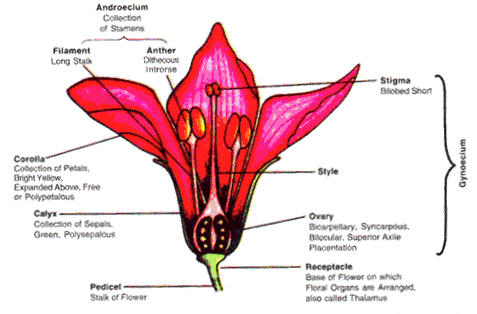
A typical flower has four different kinds of whorls arranged successively on the swollen parts of a flower stalk. Flower stalk consists of the stalk called pedicel and the swollen upper part called thalamus bearing the floral leaves.
The different floral whorls are calyx, corolla, androecium and gynoecium. Calyx and corolla are accessory whorls, while androecium and gynoecium are reproductive whorls.
(i) Calyx - The calyx is the outermost whorl of the flower and its members are called sepals. Generally, sepals are green, leaf like and protect the inner whorls of the flower in bud stage. They are also involved in producing food by photosynthesis. The calyx may be gamosepalous (sepals united) or polysepalous (sepals free).
(ii) Corolla - It is the second whorl composed of floral leaves called petals. Petals are usually brightly coloured to attract insects for pollination. Petals also protect the inner whorls. Like calyx, corolla may be also free (gamopetalous) or united (polypetalous). The shape and colour of corolla vary greatly in plants.
(iii) Androecium - It is the third whorl and is the male reproductive whorl of a flower. Androecium is composed of one or more stamens. Each stamen consists of three parts:
(a) Filament - It is the lower stalk of the stamen.
(b) Anther - Filament bears a bilobed fertile structure called anther at its distal end. Each lobe contains two pollen sacs. The pollen grains are produced in pollen-sacs.
(c) Connective - Filament of the stamen is extended in between the two anther lobes called connective.
(iv) Gynoecium - It is the innermost whorl and the female reproductive part of the flower. Gynoecium is made up of one or more carpels. A carpel consists of three parts namely stigma, style and ovary.
Ovary is the swollen basal part containing ovules. Each ovary bears one or more ovules attached to a flattened, cushion-like structure called placenta.
Style is the elongated thread like structure attached to the apex of the ovary. It connects the ovary to the stigma.
The stigma is situated at the tip of the style and is the receptive surface for pollen grains.

Solution 2
(a) Inflorescence - The arrangement of flowers on the floral axis is called inflorescence.
Function - Inflorescence facilitates the best arrangement and display of flowers on a branch without any sort of overcrowding. It also facilitates pollination via a prominent visual display and more efficient pollen uptake and deposition.
(b) Gynoecium - It is the innermost whorl of the flower bearing the female reproductive parts.
Function - The ovary of gynoecium produces ovules which bear the female gamete.
(c) Placentation - The manner in which placenta and ovules are arranged inside the ovary wall is known as placentation.
Function - Placentation helps in the best arrangement of ovules within the ovary. Placentation also helps in plant classification.
(d) Incomplete flower - A flower lacking one whorl out of the four whorls is said to be incomplete flower.
Function - An incomplete flower contains either male or female reproductive organs.
(e) Perianth - When the calyx and corolla are not distinct in a flower (eg. - lily), the whorl is collectively called perianth.
Function - The members of perianth, called tepals are usually brightly coloured and bear scent. This attracts insects which aids in pollination. They also protect the flower in bud condition.
Function - Inflorescence facilitates the best arrangement and display of flowers on a branch without any sort of overcrowding. It also facilitates pollination via a prominent visual display and more efficient pollen uptake and deposition.
(b) Gynoecium - It is the innermost whorl of the flower bearing the female reproductive parts.
Function - The ovary of gynoecium produces ovules which bear the female gamete.
(c) Placentation - The manner in which placenta and ovules are arranged inside the ovary wall is known as placentation.
Function - Placentation helps in the best arrangement of ovules within the ovary. Placentation also helps in plant classification.
(d) Incomplete flower - A flower lacking one whorl out of the four whorls is said to be incomplete flower.
Function - An incomplete flower contains either male or female reproductive organs.
(e) Perianth - When the calyx and corolla are not distinct in a flower (eg. - lily), the whorl is collectively called perianth.
Function - The members of perianth, called tepals are usually brightly coloured and bear scent. This attracts insects which aids in pollination. They also protect the flower in bud condition.
Solution 3
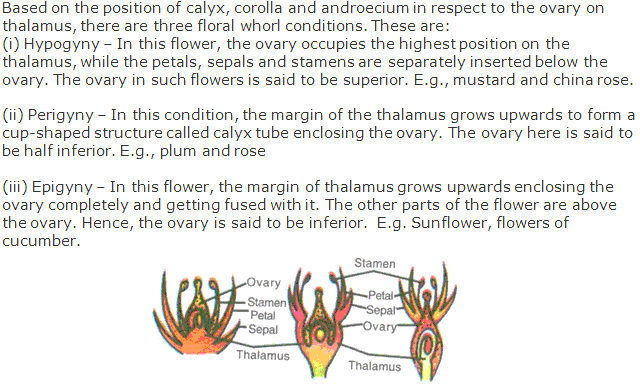
Solution 4
The flower is the reproductive unit in the angiosperms and is meant for sexual reproduction. Flowers produce seeds from which new plants grow in future. So the main function of flower is to perpetuate the species.
There are six different types of flowers. These are complete, incomplete, bisexual, unisexual, actinomorphic and zygomorphic.
There are six different types of flowers. These are complete, incomplete, bisexual, unisexual, actinomorphic and zygomorphic.
Solution 5
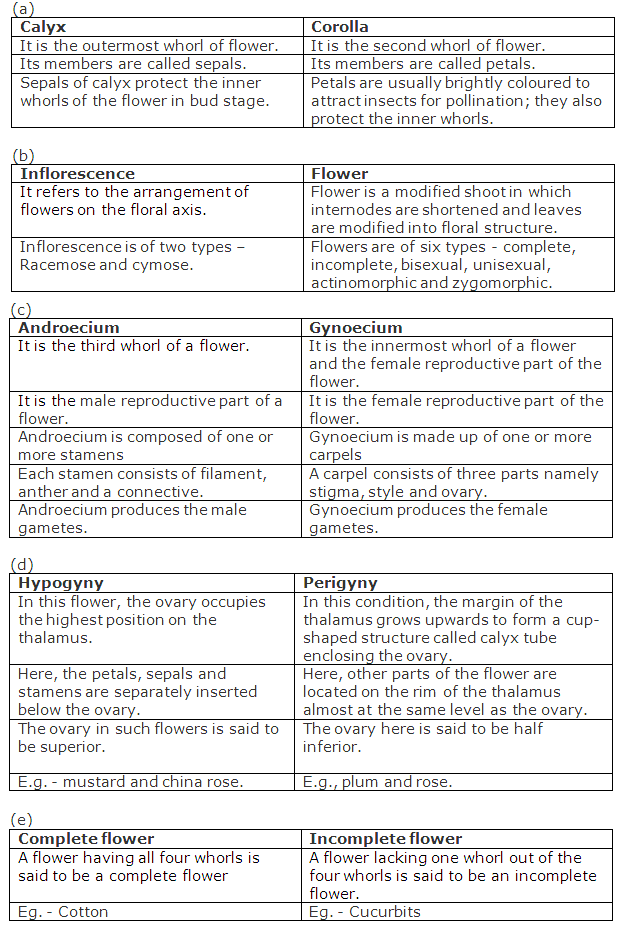
Solution 6
In certain flowers like tomato and brinjal, the calyx remains attached even after the formation of the fruit and does not wither away. Such calyx is called persistent calyx.
Solution 7
Calyx is the outermost whorl of a flower which is composed of sepals. Generally these sepals are green, leaf like and protect the inner whorls of the flower in bud condition. They are also involved in producing food by photosynthesis.
Solution 8

Solution 9
Corolla is the second whorl composed of floral leaves called petals. Petals are usually brightly coloured to attract insects for pollination. Petals also protect the inner whorls. The shape and colour of corolla vary greatly in plants.
Solution 10
The androecium and gynoecium are the essential parts of a flower because they are involved in sexual reproduction.
Androecium is the male reproductive organ of a flower and is involved in producing male gametes.
Gynoecium is the female reproductive part of the flower and produces the female gametes.
The non-essential or accessory parts of flowers are the calyx and corolla since they do not directly participate in the process of sexual reproduction leading to the development of seed.
Sepals of calyx are green, leaf like and protect the inner whorls of the flower in bud stage. They are also involved in producing food by photosynthesis.
Petals of corolla are usually brightly coloured to attract insects for pollination; they also protect the inner whorls.
Androecium is the male reproductive organ of a flower and is involved in producing male gametes.
Gynoecium is the female reproductive part of the flower and produces the female gametes.
The non-essential or accessory parts of flowers are the calyx and corolla since they do not directly participate in the process of sexual reproduction leading to the development of seed.
Sepals of calyx are green, leaf like and protect the inner whorls of the flower in bud stage. They are also involved in producing food by photosynthesis.
Petals of corolla are usually brightly coloured to attract insects for pollination; they also protect the inner whorls.
Solution 11
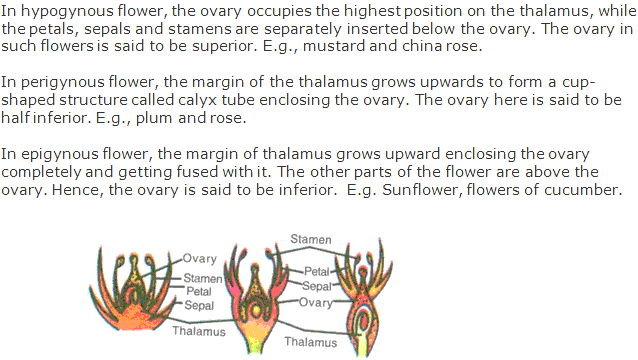
Solution 12
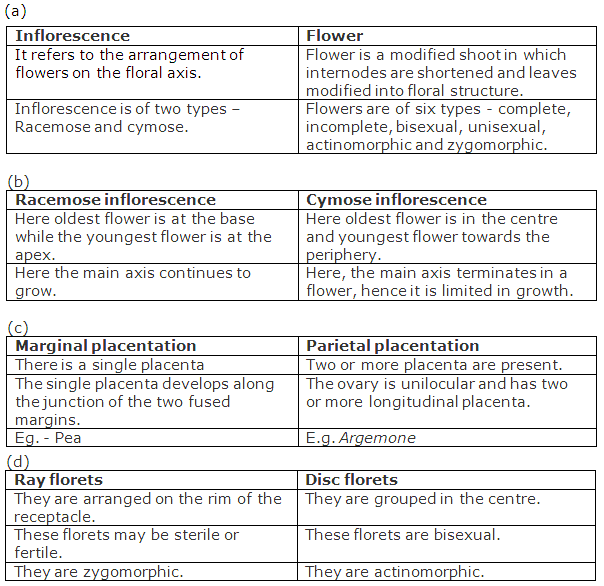
Solution 13
(a) Androecium - It is the third whorl and is the male reproductive organ of a flower. Androecium is composed of one or more stamens. Each stamen consists of three parts: Filament, Anther and Connective. The pollen grains are produced in pollen-sacs on the anthers.
(b) Gynoecium - It is the innermost whorl and is the female reproductive part of the flower. Gynoecium is made up of one or more carpels. A carpel consists of three parts namely stigma, style and ovary. Ovary is the swollen basal part containing ovules.
(c) Calyx - The calyx is the outermost whorl of the flower and its members are called sepals. Generally, sepals are green, leaf like and protect the inner whorls of the flower in bud stage. They are also involved in producing food by photosynthesis. The calyx may be gamosepalous (sepals united) or polysepalous (sepals free).
(d) Corolla - It is the second whorl composed of floral leaves called petals. Petals are usually brightly coloured to attract insects for pollination. Petals also protect the inner whorls. Like calyx, corolla may be also free (gamopetalous) or united (polypetalous).
(b) Gynoecium - It is the innermost whorl and is the female reproductive part of the flower. Gynoecium is made up of one or more carpels. A carpel consists of three parts namely stigma, style and ovary. Ovary is the swollen basal part containing ovules.
(c) Calyx - The calyx is the outermost whorl of the flower and its members are called sepals. Generally, sepals are green, leaf like and protect the inner whorls of the flower in bud stage. They are also involved in producing food by photosynthesis. The calyx may be gamosepalous (sepals united) or polysepalous (sepals free).
(d) Corolla - It is the second whorl composed of floral leaves called petals. Petals are usually brightly coloured to attract insects for pollination. Petals also protect the inner whorls. Like calyx, corolla may be also free (gamopetalous) or united (polypetalous).
Flowers Exercise 65
Solution 14
(a) Datura
(b) Cotton
(c) Cotton
(d) Sunflower
(e) Tomato
(f) Mulberry
(b) Cotton
(c) Cotton
(d) Sunflower
(e) Tomato
(f) Mulberry
Solution 15
(i) (b) condensed stem
(ii) (b) jointed calyx
(iii) (c) thalamus
(iv) (a) reniform
(v) (c) capitulum
(ii) (b) jointed calyx
(iii) (c) thalamus
(iv) (a) reniform
(v) (c) capitulum
